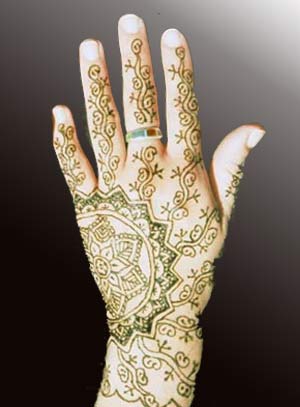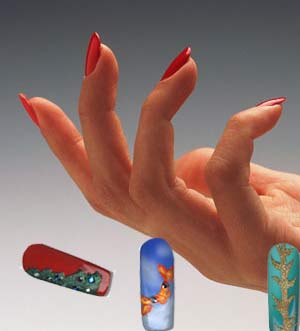Henna Design

The history of henna or rather that of applying mehendi dates back nearly 5000 years. The earliest written artifact that mentions henna being used specifically as an adornment for a bride or woman's special occasion is in the Ugaritic legend of Baal and Anath, inscribed on a tablet from about 2100 BCE, from north west Syria. The most complex and elegant henna patterning in the Islamic world was from 900 to 1550 AD in Persia, Turkey and Iraq.
Henna holds special significance in the Asian context too. Betrothals, weddings and religious festivals are occasions when Indian women apply henna patterns on their hands and feet. Intricately woven henna designs adorn most Asian brides. Henna tattoos are popular with
Henna tattoo
Henna tattoos are a good alternative to permanent tattoos as they can be easily removed. Unlike permanent tattoos, henna tattoos last for just a month at the most. Henna tattoos are painted on the skin and they leave a stain that is reddish brown or even black.
Such tattoos done with Henna are relatively safer. Removal of henna tattoos is simple and uncomplicated. You can use a soap and loofah over the tattoo to fade off your henna tattoo. Regular exfoliation of the skin will also help to remove the henna tattoo faster.
Henna History
From the lacy floral patterns of India to the geometric patterns of Africa and the large floral patterns of Arabia, henna is considered auspicious and has been part of traditional body art. The henna plant (hawsonia inermis) holds special significance in India, Pakistan, Malaysia, Persia, Syria, Egypt, Morocco and Sudan. The temporary stain created by a paste of crushed henna leaves has been used to adorn women.
Leaves of other plants such as indigo, tea, coffee and tamarind are used to enhance the color and longevity of the henna design. Henna is also known to have medicinal properties. It is used to heal skin diseases and cool the skin in hot climates. Henna powder is actually made into a paste before application. The powder itself is green in color. It leaves an orange color after it is applied and left on for some time.
There are various types of colored henna but they could cause allergic reactions. Henna is best when applied in its purest form. Grades of henna powder can be determined by its color, purity and fineness. The henna that is used to color and condition the hair is less refined and contains other ingredients. Henna for body decoration is pure and filtered. The most expensive henna is finely ground - fresh, nearly dustless, pure and soft green. It gives the brightest color.
Bridal Henna
Mehendi or henna plays a very important role in Indian and other Asian marriages. Intricate henna patterns are applied on the hands and feet of the bride in most Asian cultures. It is a common belief that the darker the color on the bride's hands, the better their married life. The names of the bridegroom are often enmeshed within the intricate swirls and curls of the henna patterns.
In fact, applying bridal mehendi forms an intricate part of the wedding festivities. Womenfolk gather together amidst joyful singing and dancing as the henna artist applies patterns of flowers, birds and geometrical shapes. Bridal henna patterns include flower arches, flowery trails, leaves and chains. Intricate patterns are applied on the hands right up to the forearms.
Art of Henna
The henna powder is usually mixed with water and made into a thick henna paste. It is then filled into cones. The tip of the cone must have a hole just enough to allow a smooth flow of the henna paste to make intricate designs. Once the design is applied, it is allowed to dry. The henna tends to give away a darker color if kept for a longer time. Lime and sugar water is periodically dabbed on the henna patterns to keep them damp and prevent cracking. Another method of applying mehendi is by spreading a henna stencil over the hand or any other body part and then applying henna paste all over the stencil.
Applying Mehendi Designs
- Sift the henna powder, remove the debris and make a smooth paste with the henna powder by adding to it a hot mixture of tea or coffee till it reaches mud like consistency.
- Fill a plastic cone with henna paste. There should be a small hole to allow the paste to ooze out.
- Hold the cone in the right hand and carefully make patterns by squeezing out the paste in a smooth and even manner.
- Keep the palm horizontal till the patterned side dries.
- Mehendi tends to give off a darker due if exposed to heat. The longer the mehendi is kept on, the darker the color.
- Keep it as long as possible. Then scrape it off.
- The color will vary from person to person.
Henna kit
A mehendi kit would give you mehendi powder, stencils and henna design pages. A basic henna kit normally contains:
- Henna powder
- Applicator bottles
- Essential lavender or eucalyptus oil
- Designs
- Stencils
- Cones
- Mixing cups
- Cotton balls
- Stirrers
Some henna kits are customized with ready to use henna paste and stencils. The ingredients can also be bought separately
Henna Stencil
Henna stencils are ideal for those who have minimal drawing skills. Choose from a wide range of stencils available for henna patterns. Place the henna stencil over the body part and apply henna or body paint over it and Voila - you have a henna design in place! Henna stencils can be used for creating a central focus theme for your mehendi design. You can elaborate on them too. Large henna stencils work well for the upper back, lower back and chest. Smaller finer stencils can be used for cuffs, anklets and armbands. Choose from plastic reusable stencils or those with adhesive backs.
Arabic Henna Design
Henna patterns tend to differ from country to country and from different cultures too. Each style is distinct. Arabic henna patterns are usually created from black henna. Asian mehendi designs are typically reddish brown. Arabic henna designs vary from the Indian mehendi patterns in that they are large and floral whereas the Indian designs are floral and paisley. Asian henna patterns tend to be composed of repetitive patterns of lines, leafy tendrils, teardrops and abstract shapes. Arabic henna designs are inspired by Arabic art.
Top of the Page: Henna Design
Tags:#henna #henna design #henna pattern #art of henna #henna powder #henna kit #henna stencil #Arabic henna design #henna history #henna paste #bridal henna
 Temporary Body Art
Temporary Body Art Nail Art
Body Painting
Face Painting
Henna Design
Laser Tattoo Removal
Tattoo Art
Body Piercing
Top of the Page: Henna Design
Popularity Index: 101,954

